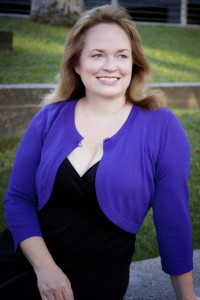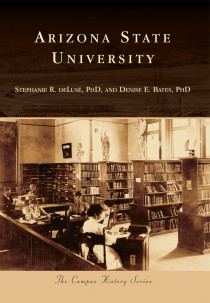 Mesa Community College alumna Stephanie R. deLusé
Do you know the details of how Arizona State University’s “Sparky” mascot originated, or the history of the campus Victory Bell? Find out by reading “Arizona State University,” a new book by Mesa Community College alumna Stephanie R. deLusé, co-authored by Denise Bates.
Mesa Community College alumna Stephanie R. deLusé
Do you know the details of how Arizona State University’s “Sparky” mascot originated, or the history of the campus Victory Bell? Find out by reading “Arizona State University,” a new book by Mesa Community College alumna Stephanie R. deLusé, co-authored by Denise Bates.
Current and past students will enjoy learning about ASU’s history and how the university has grown to include four campuses and 70,000 students. Stephanie, whose relationship with the university began when she was a child who roller-skated around the campus, offers a photographic narrative of the faculty, staff, students, alumni, and citizens of ASU.
Stephanie earned an associate’s degree in communication at MCC in 1988 and went on to earn a master’s degree and Ph.D. in Psychology at ASU. She has work forthcoming or in literary journals such as The Griffin, The MacGuffin, Emrys, Wild Violet Magazine, The Legendary, and TRIVIA: Voices of Feminism, and in academic journals including Family Court Review, Issues in Integrative Studies, and Family Process. On the popular side, she has essays in books like: The Psychology of Survivor, The Psychology of Joss Whedon, and The Psychology of Superheroes. By day, she professes in Barrett, the Honors College at ASU. Her teaching has won her awards, including “Last Lecture,” and her writing has earned a Pushcart nomination.
Stephanie shared a few thoughts with our readers on her journey after MCC:
 Arizona State University
Q: How did your MCC experience help prepare you for your current career?
Arizona State University
Q: How did your MCC experience help prepare you for your current career?
A: MCC gave me an excellent base on which to build. The classes I took were rigorous and taught by strong faculty. They were fine examples to draw on when I later became a professor myself. In terms of the Communication degree, I transferred seamlessly to ASU to continue majoring in Communication. There I dug into three emphasis areas—interpersonal, intercultural, and organizational communication. I shot to the top of my classes at ASU and surely MCC deserves some of the credit for that. I went on to get a Masters and PhD in Psychology (emphasis in social psychology) and continue to draw on communication skills and theory to this day in daily life and in academic pursuits.
Q: How did the book project come about?
A: As an Arizona native, I am amazed at how much the Valley of the Sun has changed just in my lifetime. I witnessed a lot of change at ASU as well, and was worried that so much of the great history would be lost if it wasn’t collected and shared. I’ve spent my adult life at ASU either as a student or a teacher, and while I appreciate the changes and growth, it seemed important to remember its exciting origin story and honor the great citizens, students, faculty, and staff that helped make what ASU is today possible.
There’s so much interesting and important work that goes on at a university that many might not realize…this book helps show some glimpses of that and illustrates the tight connection between the community and the university. They really are tightly intertwined institutions like MCC and ASU are critical to the well-being of the community on so many levels, and the institutions wouldn’t be there without the community. It’s a win-win.
Q: Tell us about the process.
A: My co-author and I read researched information, interviewed as many “old-timers” as we could find to collect memories and old photos to capture history from the very beginning until now. In the end, we used 229 photos of thousands that we saw, and it really is a beautiful and easy-to-read book while still conveying a lot of information.
Q: Tell us about your role in MCC’s 1988 Commencement Services.
A: I was one of the commencement speakers in spring of 1988. All the 4.0 students were invited to audition to deliver the student speech. I don’t remember how many of us actually auditioned for a group of faculty, but they made a very interesting decision. Apparently three of us had done a fine job but took very different perspectives on the graduation speech—one focused on the past, one focused on the present (me), and one on the future. Each had something unique to offer so instead of picking one, they had all three of us speak in that order! I think that was the first year (and probably the last) they did that. It was very exciting to be on the stage on the football field to address an audience of graduates and their families and friends in the stands. I remembered from my public speaking class to gesture BIGGER to be seen by those all the way across the field, way back in the stands. It wasn’t my first public speech but it was my first in front of such a large audience, and it was an excellent experience. I continue to speak to large audiences to this day and am sure that early experience helped build the skills I’m praised for now.
Q: What are your future plans?
A: Denise and I are at the early stages of another book that is historic and community oriented.
For a brief video book preview of the ASU book, visit: www.ASUhistory.com.

